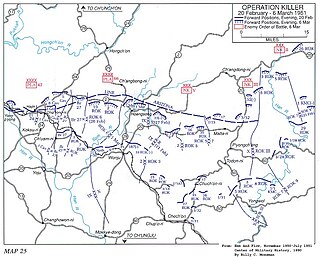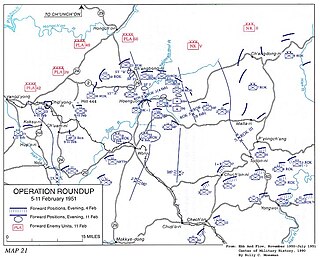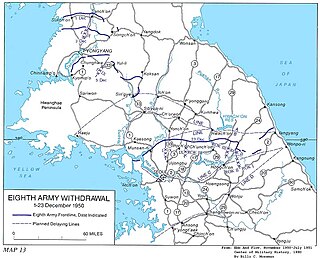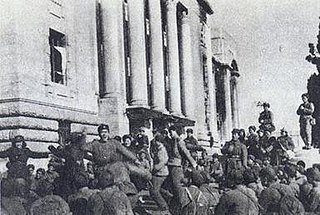
Operation Ripper, also known as the Fourth Battle of Seoul, was a United Nations (UN) military operation conceived by the US Eighth Army, General Matthew Ridgway, during the Korean War. The operation was intended to destroy as much as possible of the Chinese People's Volunteer Army (PVA) and Korean People's Army (KPA) forces around Seoul and the towns of Hongch'on, 50 miles (80 km) east of Seoul, and Chuncheon, 15 miles (24 km) further north. The operation also aimed to bring UN troops to the 38th Parallel. It followed upon the heels of Operation Killer, an eight-day UN offensive that concluded February 28, to push PVA/KPA forces north of the Han River. The operation was launched on 6 March 1951 with US I Corps and IX Corps on the west near Seoul and Hoengsong and US X Corps and Republic of Korea Army (ROK) III Corps in the east, to reach the Idaho Line, an arc with its apex just south of the 38th Parallel in South Korea.

The Hungnam evacuation or Heungnam redeployment, also known as the Miracle of Christmas, was the evacuation of United Nations (UN) forces and North Korean civilians from the port of Hungnam, North Korea, between 15 and 24 December 1950 during the Korean War. As part of the fighting withdrawal of UN forces against the People's Volunteer Army (PVA) during the Battle of the Chosin Reservoir, they abandoned some 59,000 square kilometers of North Korean territory to enemy forces and retreated to Hungnam from where they were evacuated to South Korea.

Operation Courageous was a military operation performed by the United Nations Command (UN) during the Korean War designed to trap large numbers of Chinese People's Volunteer Army (PVA) and Korean People's Army (KPA) troops between the Han and Imjin Rivers north of Seoul, opposite the Republic of Korea Army (ROK) I Corps. The intent of Operation Courageous was for US I Corps, which was composed of the US 25th and 3rd Infantry Divisions and the ROK 1st Infantry Division, to advance quickly on the PVA/KPA forces and reach the Imjin River with all possible speed.

Operation Killer was the start of the second major counter offensive launched by United Nations Command (UN) forces against the Chinese Communist People's Volunteer Army (PVA) and the North Korean Army (KPA) during the Korean War between 20 February and 6 March 1951. The offensive was formulated by General Matthew Ridgway with the goal of annihilating enemy forces south of a line designated the Arizona Line. The operation was immediately followed by Operation Ripper.

Operation Roundup was an advance by United Nations Command (UN) forces during the Korean War that took place from 5 to 11 February 1951. While achieving initial success against limited opposition, it was brought to a halt by Chinese People's Volunteer Army (PVA) and North Korean Korean People's Army (KPA) forces at the Battle of Hoengsong.
The Battle of Chuam-ni was a battle fought between 14–17 February 1951, at Chuam-ni, South Korea, as part of the Chinese People's Volunteer Army (PVA) Third Offensive towards Wonju during the Korean War. The battle was for control of the supply line Route 24.

The Battle of Chipyong-ni, also known as the Battle of Dipingli, was a decisive battle of the Korean War that took place from 13 to 15 February 1951 between US and French units of the US 23rd Infantry Regiment and various units of the Chinese People's Volunteer Army (PVA) around the village of Chipyong-ni. The result was a United Nations Command victory. The battle, along with the Third Battle of Wonju, has been called "the Gettysburg of the Korean War", and represents the "high-water mark" of the Chinese invasion of South Korea. Due to the ferocity of the Chinese attack and the heroism of the defenders, the battle has also been called "one of the greatest regimental defense actions in military history".
The Battle of Maehwa-San was a battle fought for control of the hills and area around Maehwa mountain between the Hoengseong County and Wonju, between 7–12 March 1951, during the Korean War. The British Empire 27th British Commonwealth Brigade was tasked with eliminating the Chinese People's Volunteer Army (PVA) and Korean People's Army (KPA) forces occupying the area.

The First and Second Battles of Wonju, also known as the Wonju Campaign or the Third Phase Campaign Eastern Sector, was a series of engagements between North Korean and United Nations (UN) forces during the Korean War. The battle took place from December 31, 1950, to January 20, 1951, around the South Korean town of Wonju. In coordination with the Chinese capture of Seoul on the western front, the North Korean Korean People's Army (KPA) attempted to capture Wonju in an effort to destabilize the UN defenses along the central and the eastern fronts.

The Chinese spring offensive, also known as the Chinese Fifth Phase Offensive, was a military operation conducted by the Chinese People's Volunteer Army (PVA) during the Korean War. Mobilizing three field armies totaling 700,000 men for the operation, the Chinese command conducted their largest offensive operation since their Second Phase Offensive in November and December 1950. The operation took place in the summer of 1951 and aimed at permanently driving the United Nations Command (UN) forces off the Korean peninsula.

The Battle of Hoengsong, also known as Hoengsong Counteroffensive was a battle during the Korean War that took place between February 11–15, 1951. It was part of the Chinese People's Volunteer Army (PVA) Fourth Phase Offensive and was fought between the PVA and United Nations forces. After being pushed back northward by the UN's Operation Thunderbolt counteroffensive, the PVA was victorious in this battle, inflicting heavy casualties on the UN forces in the two days of fighting and temporarily regaining the initiative.

Operation Dauntless was a military operation performed by the United Nations Command (UN) during the Korean War designed to advance the UN lines to positions 10–20 miles (16–32 km) north of the 38th Parallel designated the Wyoming Line which would threaten the Chinese and North Korean logistics hub marked out by the towns of Pyonggang, Ch'orwon and Gimhwa-eup named the Iron Triangle. The operation immediately succeeded Operation Rugged which took the UN forces to the Kansas Line 2 to 6 miles north of the 38th Parallel. The operation was initially successful, reaching its initial objectives, but was brought to a halt by the Chinese Spring Offensive on 22 April 1951.

The Battle of the Soyang River, also referred to as the "May Massacre", was fought during the Korean War between United Nations Command (UN) and the Chinese People's Volunteer Army (PVA) and Korean People's Army (KPA) during the Spring Offensive of April–May 1951. The attack took place across the entire front but with the main thrust below the Soyang River in the Taebaek Mountains. The objective of the main effort was to sever the six Republic of Korea Army (ROK) divisions on the eastern front from the remainder of the US Eighth Army and annihilate them and the US 2nd Infantry Division. Secondary attacks would be mounted by PVA and KPA forces across the entire front.

The UN May–June 1951 counteroffensive was a military operation performed by the United Nations Command (UN) during the Korean War launched in response to the Chinese spring offensive of April-May 1951. It was the final large-scale offensive of the war that saw significant territorial changes.

The Third Battle of Wonju, was a series of engagements between North Korean and United Nations (UN) forces during the Korean War. The battle took place from 13 to 18 February 1951 north of the South Korean town of Wonju.
The UN offensive into North Korea was a large-scale offensive in late 1950 by United Nations (UN) forces against North Korean forces.

The UN retreat from North Korea was the withdrawal of United Nations (UN) forces from North Korea that took place from 2–25 December 1950.
The Pohang Operation was an anti-guerilla operation during the Korean War between United Nations Command (UN) and North Korean forces near Pohang from 10 January to 11 February 1951.














